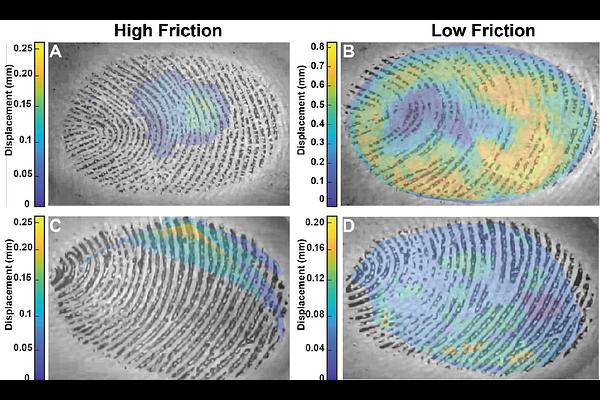Role of finger movement kinematics in friction perception at initial contact with smooth surfaces

Role of finger movement kinematics in friction perception at initial contact with smooth surfaces
Afzal, H. M. N.; Dullinac, S. d. B. d.; Loutit, A.; Shea, H. O.; Martinez Ulloa, P. M. U.; Khamis, H.; Vickery, R. M.; Wiertlewski, M.; Redmond, S. J.; Birznieks, I.
AbstractWhen manipulating objects, humans adjust grip force to friction remarkably quickly: it may take just 100 ms to see an adjustment to friction at the skin-object interface. While the motor commands adapt, subjects become aware of the slipperiness of touched surfaces. In this study, we explore the sensory processes underlying such friction perception when no intentional exploratory sliding movements are present. Previously, we have demonstrated that humans cannot perceive frictional differences when surfaces are brought in contact with an immobilized finger (Khamis et al., 2021b) unless there is a submillimeter lateral displacement (Afzal et al., 2022), or subjects made the movement themselves (Willemet et al., 2021). In the current study, subjects actively interacted with a device that can modulate friction using ultrasound, without an exploratory sliding movement, as they would when gripping an object to lift it. Using a two-alternative forced-choice paradigm, subjects had to indicate which of two surfaces felt more slippery. Subjects could correctly identify the more slippery surface in 87 {+/-} 8% of cases (mean {+/-} SD; n=12). Biomechanical analysis of finger pad skin contacting a flat smooth surface indicated that natural movement kinematics (e.g., tangential movement jitter and physiological tremor) may enhance the perception of frictional effects. To test whether this is the case, in a second experiment a hand support was introduced to limit fingertip movement deviation from a straight path. Subject performance significantly decreased (66 {+/-} 12% correct, mean {+/-} SD; n=12), indicating that friction perception at the initial contact is enhanced or enabled by natural movement kinematics.